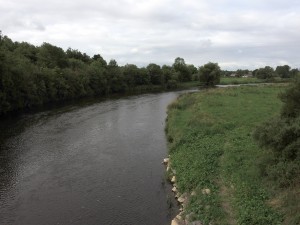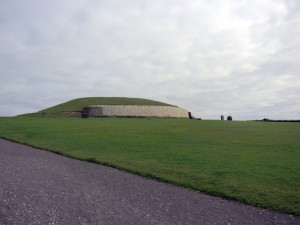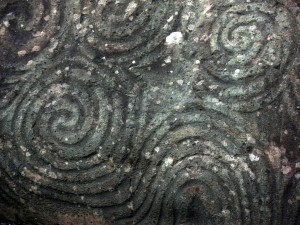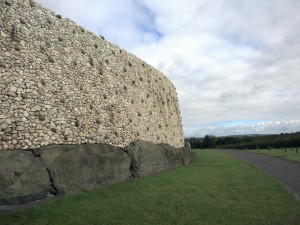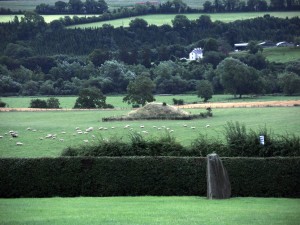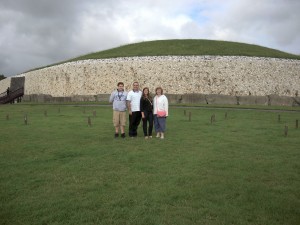Newgrange: The Mystery of Prehistoric Man
Posted by in TravelOne of things you realize about America when you travel abroad is that it really is the New World. What we think of as old is practically yesterday in Europe. It’s not until you walk in castles or colosseums built before Europeans set foot in or imagined America that you get a sense of how recent everything on our continent is.
After visiting England, Scotland, and Italy, I thought I had a pretty good grasp of this. Knights and gladiators were something I could visualize. And then we went to Newgrange in Ireland. I had never heard of Newgrange until I began researching our trip, but my History
Channel-watching son knew all about it. Located about half an hour north of Dublin, Newgrange is a passage tomb built more than 5000 years ago. Think about that. 5000 years.
3000 years before the birth of Christ (and we think the Liberty Bell is old). I can’t even imagine what life was like then and we have no historical events we can tie it to. It’s practically forever ago.
A passage tomb is a tomb characterized by a long passage with a burial chamber, all underground, usually made of stone.
Getting There
To get to Newgrange, you must go to the Brú na Bóinne Visitors’ Center and take a guided tour to the site. The visitors’ center also has tours to Knowth, a similar passage tomb. 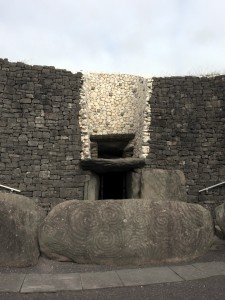 We had our own vehicle and drove up from Dublin. You can also arrange for a day tour that will take you to the visitor’s center from Dublin. Our GPS was not very helpful in finding this, so I highly recommend you take down the GPS coordinates that are on the official site.
We had our own vehicle and drove up from Dublin. You can also arrange for a day tour that will take you to the visitor’s center from Dublin. Our GPS was not very helpful in finding this, so I highly recommend you take down the GPS coordinates that are on the official site.
The Visitor’s Center is located in the middle of nowhere. You wouldn’t think you were going anywhere well known as you zig and zag down some one lane country roads. Eventually you see a little sign and pull into the parking lot. This was one of the parking lots on our trip that made me nervous about the safety of our possessions (all of our luggage was in the van). There are signs warning not to leave anything valuable in the car due to frequent break-ins (why then is there no security or video surveillance?). Some parts of the lot are far away and ringed with vegetation, making some cars not very visible. To add to my worry, the lot is not directly next to the center; you must walk along a covered path to get there. My wonderful husband found a spot directly next to the path and backed the van up so that the back door was almost directly against a small hill (making it impossible to open), so that I was able to breathe and not worry incessantly about the car.
Despite warnings in my guide book that tours fill up quickly, with the entire day often sold
out by 10 am, when we arrived around 10 am on an August Friday, there were very few visitors and we were scheduled for the next tour which left in ten minutes.
To get to the tour bus, you must walk across a bridge over a perfect gurgling river and through some woods to a little bus stop where 4 shuttle buses take visitors to and from the sites. Everyone who worked here was friendly, welcoming, and helpful.
Welcome to the Past
We hopped on the shuttle and it drove down more country roads, past farms (interestingly, there is a town called Drogheda here we passed signs for – if you’ve ever read The Thorn Birds, you know this was the name of the sheep farm in the book) and sheep until it pulled up in front of the Newgrange site. Visitors get off the bus and gather at a small building where the tour guide meets you. This was all very casual – no lines, no big groups of people. At the top of the hill is the
imposing tomb. This does not look like a prehistoric site. It looks like a newly constructed bunker.
Our guide led us to the opening of the tomb where she pointed out the rocks with the symbols made by the people who created the tomb. These are beautiful symbols, but no one knows for sure what they mean. The outside of the tomb has been repaired and the entrance has been made more accessible with some stairs. Our guide talked to us about the people who built this tomb and pointed out that the countryside in this area is littered with these types of tombs (in my photo below, you can see a small bump in the middle of a sheep pasture – that is another tomb), although Newgrange is the largest. Most have not been excavated because there are simply too many. The tombs seem to not only be
for burial but also for memorial and as a way of marking territory or areas, as well as for possible religious reasons.
Our group was divided in half for entry into the tomb because although the outdoor structure is gigantic, the inside of the tomb is actually very small. She explained that the passageway is very narrow and instructed us that we had to take all bags and purses off our shoulders and carry them near the ground, where the widest part of the tomb is (I imagine this is the case since they slid or rolled stones in along the floor). Both my son and I, who are none too fond of enclosed spaces, were slightly nervous about going in, but I’m not about to
let some irrational fear stop me from seeing something made 5000 years ago! We entered the tomb single file, ducking to get in. It starts out pretty comfortably but as you move through, there a couple of spaces where you wonder “Am I going to fit?” as you duck and turn sideways. I kept telling myself all the people in front of me had managed and I could too. Before you know it, you are into the open part of the tomb and you can breathe. It’s actually a very short passageway and I think most people would have no trouble physically fitting or mentally coping.
Entering a Mystical Space
The inside is magnificent (and no photos were allowed so you will have to let my words show you). The narrow hallway opens up into a round center section where our group of 15 were able to stand comfortably. The roof above our heads was rounded and made up of gradually layered stones, climbing around and around, up to the ceiling. It had a beehive feel to it and was a very high ceiling, possibly 20 feet high or more at the center. Our guide told us that this portion of the tomb has been untouched and unrestored. Construction that has lasted more than 5000 years is astounding to see. If only the roof on my house could last this long.
Off of the center section, there are three small little cubbies. Each one has what looks like a giant shallow stone bowl sitting on stones. This is where the remains were placed. There are carvings and symbols on the walls.
Seeing the Light
This tomb goes beyond burial. It also has astronomical significance. At sunrise on the winter solstice and only then, the sun shines directly through an opening above the door and completely illuminates the inside of the tomb (there is a lottery to win tickets to be present for this event). Or guide first turned off the artificial lights so we could experience what the tomb is naturally like on a normal day and it was astounding to be in such complete and utter darkness. If you think about it, we are almost never in total darkness. When we turn off the lights in our homes there are alarm clocks, DVRs, and appliances with displays shining, not to mention the street lights and light from our neighbors. Even if you go into the forest or desert at night, there is light from the moon and stars. The inside of this tomb has absolutely no light. The darkness is heavy, rich, and velvety. Then our guide turned on an artificial light that recreates the rise of the sun on the solstice. It was simply magical to see and feel the light moving through the tomb. It filled the space with vibrancy and life. It is very clear that this moment once a year had a deep significance to the people who built this tomb. I could imagine what it would have been like to be there for this highly awaited event and feel the power of the sun that had somehow been captured by humans.
In that tomb, I felt deeply connected to these ancestors who had a necessary connection to the sun and rhythm of nature. It is hard to imagine that people who themselves lived in dwellings that did not last could build something so huge and magnificent to honor their dead and to be connected to the universe. The amount of resources, energy, and time that were put into creating this tomb is truly difficult to grasp, given their technology and the harshness of their lives.
We came out of the tomb and walked around it while the second half of our group went inside. There is a beautiful 360 view of the green rolling countryside from the tomb’s hill and I could imagine a group of people looking out and thinking “all of this is ours and we have put this marker here so everyone will know.”
Back to Reality
The shuttle took us back to the visitor’s center where I again realized that perhaps my true calling in life is to be a merchandiser for gift shops. The selections were not great. First of all, you’ve got to have a great t-shirt and a really good magnet (please – no more of the rectangular magnets with just a boring photo of the location) at major historical sites. There were stunning and moving designs on the outside and inside of the tomb – I would have expected jewelry, art, and other items depicting these. There were some local artists set up inside the center center selling their work, but none of it impressed or excited me – it had no connection to what we saw or to the countryside. So while I can’t whole-heartedly endorse the gift shop, I will tell you that the memories you will bring home from Newgrange are better than anything you could buy.
One of things you realize about America when you travel abroad is that it really is the New World. What we think of as old is practically yesterday in Europe. It’s not until you walk in castles or colosseums built before Europeans set foot in or imagined America that you get a sense of how … Read more

